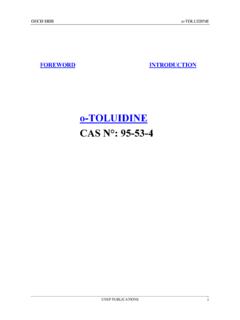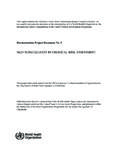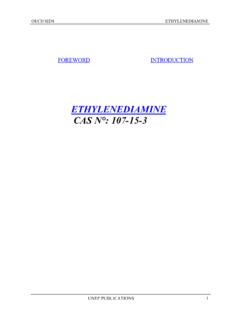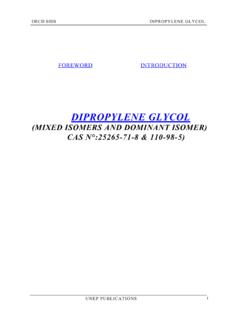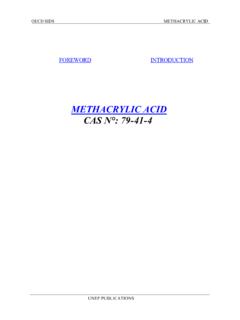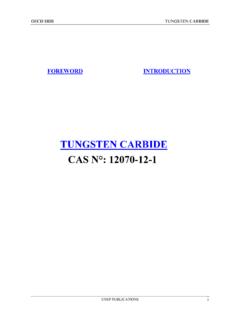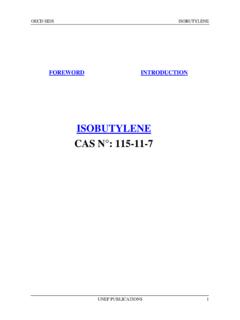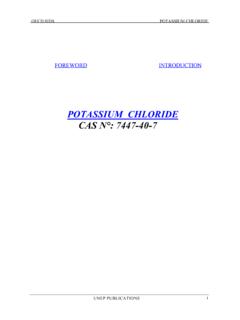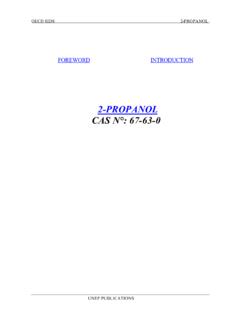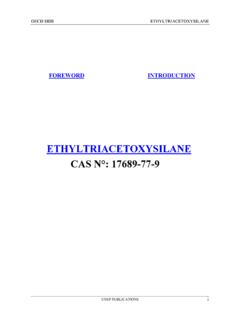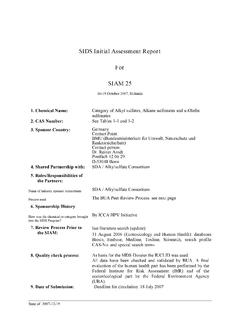Transcription of SODIUM NITRITE CAS N°: 7632-00-0 - inchem.org
1 OECD SIDS SODIUM NITRITE UNEP PUBLICATIONS 1 FOREWORD INTRODUCTION SODIUM NITRITE CAS N : 7632-00-0 OECD SIDS SODIUM NITRITE UNEP PUBLICATIONS 1 SIDS Initial Assessment Report For SIAM 20 Paris, France, 19-22 April 2005 1. Chemical Name: SODIUM NITRITE 2. CAS Number: 7632-00-0 3. Sponsor Country: Japan Mr. Motohiko Kato Director Second International Organisations Div. Ministry of Foreign Affairs 2-2-1 Kasumigaseki, Chiyoda-ku, Tokyo 100-8919 Japan 4. Shared Partnership with: Ube Industries, Ltd. Seavans North Bldg., 1-2-1, Shibaura, Minato-ku, Tokyo 105-8449 Japan Contact: Mr. Etsuro Ito Phone +81-3-5419-6242 Fax +81-3-5419-6242. Nissan Chemical Industries, Ltd, Kowa Hitotsubashi Building, 7-1, Kanda-Nishiki-cho 3-chome, Chiyoda-ku, Tokyo 101-0054 Japan Contact: Kazuo Nagashima Phone +81-3- 3296-8265 Fax +81-3-3296-8210 Mitsubishi Chemical Corporation Dai-ichi Tamachi Building, 33-8, Shiba 5-chome, Minato-ku, Tokyo 108-0014 Japan Contact: Yasukazu Uchida Phone +81-3-6414-3620 Fax +81-3-6414-3638 Sumitomo Chemical Co.
2 , Ltd. 27-1, Shinkawa 2-chome, Chuo-ku, Tokyo 104-8260 Japan Contact: Tsuneo Nara OECD SIDS SODIUM NITRITE UNEP PUBLICATIONS 2 Phone +81-3-5543-5196 Fax +81-3-5543-5909 5. Roles/Responsibilities of the Partners: Name of industry sponsor /consortium SODIUM NITRITE Consortium Process used Industry collected data, prepared the updated the IUCLID dossier, and drafted versions of the SIAR and SIAP. 6. Sponsorship History How was the chemical or category brought into the OECD HPV Chemicals Programme? This substance is sponsored by Japan under the ICCA Initiative and is submitted for first discussion at SIAM 20. 7. Review Process Prior to the SIAM: The Japanese government peer-reviewed the documents and audited selected studies. 8. Quality check process: The Japanese government peer-review committee performed spot checks on randomly selected endpoints and compared original studies with data in the SIDS Dossier.
3 9. Date of Submission: 25 July, 2005 10. Date of last Update: 22 July, 2005 11. Comments: No OECD SIDS SODIUM NITRITE UNEP PUBLICATIONS 3 SIDS INITIAL ASSESSMENT PROFILE CAS No. 7632-00-0 Chemical Name SODIUM NITRITE Structural Formula Na(NO2)- summary CONCLUSIONS OF THE SIAR Human Health SODIUM NITRITE has been reviewed by a number of international organizations: JECFA (Joint FAO/WHO Expert Committee on Food Additives); National Academy of Sciences (NAS); US National Institute of Environmental Health Sciences (NIEHS); National Institute of Public Health and the Environmental Hygiene, Netherlands; US National Toxicology Program (NTP); and California EPA (CAL/EPA). NITRITE in blood is highly reactive with haemoglobin and causes methaemoglobinaemia. Ferrous iron associated with haemoglobin is oxidized by NITRITE to ferric iron, leading to the formation of methaemoglobin.
4 Humans are considered to be more sensitive than rats in this respect. The primary acute effect of SODIUM NITRITE in rats and mice is methaemoglobinaemia. Methaemoglobin concentrations in SD rats increased from 45% to 80% over 1 hour after an oral dose of SODIUM NITRITE at 150 mg/kg bw and they returned to normal levels within 24 hours in surviving rats. LD50 values by gavage are 214 mg/kg bw (males) and 216 mg/kg bw (females) in mice. In an acute inhalation study (which could not be validated) methaemoglobin levels in female rats were significantly increased after 4 hours exposure to 10 mg/m3 SODIUM NITRITE . The increase was judged not to be haematologically significant. No significant increase was observed in exposed males. There were no toxicologically significant effects on animals maintained for 14 days post exposure.
5 No information on acute dermal toxicity is available. Based on the available information, SODIUM NITRITE is a moderate eye irritant, but is non-irritant to skin in rabbits. No studies are available investigating the sensitising potential of SODIUM NITRITE in animals. No cases of sensitisation have been reported in humans. In a repeated dose toxicity study [NTP] male and female F344/N rats were exposed to 0, 375, 750, 1500, 3000 or 5000 ppm SODIUM NITRITE (equivalent to average daily doses of approximately 0, 30, 55, 115, 200, or 310 mg/kg bw/day in males and 0, 40, 80, 130, 225, or 345 mg/kg bw/day in females) in drinking water for 14 weeks. Methaemoglobin levels were significantly elevated in all treated groups compared to the controls by the end of the treatment period. For males, mean methaemoglobin levels after 14 weeks were , , , , and g/dL at doses of 0, 30, 55, 115, 200, and 310 mg/kg bw/day.
6 For females, mean methaemoglobin levels after 14 weeks were , , , , and g/dL at doses of 0, 40, 80, 130, 225 and 345 mg/kg bw/day. The NOAELs were not determined (increased methaemoglobinaemia). The LOAELs for other endpoints were 115 mg/kg bw/day (decreased sperm motility) in males and 225 mg/kg bw/day (increased relative weight of the kidney and spleen) in females . In a second 14-week repeated dose toxicity study [NTP] male and female B6C3F1 mice were exposed to 0, 375, 750, 1500, 3000 or 5000 ppm SODIUM NITRITE (equivalent to average daily doses of approximately 0, 90, 190, 345, 750, or 990 mg/kg bw/day in males and 0, 120, 240, 445, 840, or 1230 mg/kg bw/day in females) in drinking water. Methaemoglobin levels were not reported however there were no clinical signs of toxicity. The LOAELs were 750 mg/kg bw/day (extramedullary haematopoiesis in the spleen, degeneration of the testis) in males and 445 mg/kg bw/day (extramedullary haematopoiesis in the spleen) in females.
7 In a two-year chronic toxicity/carcinogenicity study [NTP] male and female F344/N rats were exposed to 0, 750, 1500 or 3000 ppm SODIUM NITRITE (equivalent to average daily doses of approximately 0, 35, 70 or 130 mg/kg bw/day in males and 0, 40, 80 or 150 mg/kg bw/day in females) in drinking water. There were no clinical findings related to exposure. Methaemoglobin levels were measured at two weeks and three months. At both 2 weeks and three NOONa+OECD SIDS SODIUM NITRITE UNEP PUBLICATIONS 4months, methaemoglobin levels were high at night when the rats were actively feeding and drinking and low during the day when the rats were less active. Methaemoglobin levels tended to increase with increasing dosage. In a second two-year study [NTP] male and female B6C3F1 mice were exposed to 0, 750, 1500 or 3000 ppm SODIUM NITRITE (equivalent to average daily doses of approximately 0, 60, 120 or 220 mg/kg bw/day for males and 0, 45, 90 or 165 mg/kg bw/day for females) in drinking water.
8 There were no clinical findings related to exposure. At 12 months, no significant increase in methaemoglobin level was observed in either sex at any dose. Based on the two-year studies, the NOAELs for rats were 130 mg/kg bw/day in males and 150 mg/kg bw/day in females. For mice the NOAELs were 220 mg/kg bw/day in males and 165 mg/kg bw/day in females SODIUM NITRITE is a direct-acting, base-pair substitution mutagen in organisms ranging from bacteria to mammalian cells in vitro. This substance induced chromosomal aberrations in mammalian cells in vitro. There is evidence of potential in vivo genotoxicity. The substance tested positive in a micronucleus test (peripheral blood) when mice were dosed by gavage at 10 20 mg/kg bw ( 4 times at 24 hrs intervals) but was negative in a second study where mice were dosed via drinking water at dosed up to 900 mg/kg bw/day (females) for 14 weeks.
9 In a chromosomal aberration test, pregnant rats were dosed with 210 mg/kg bw/day for 13 days. Positive results for the induction of chromosomal aberrations in bone marrow of the parents and liver cells of embryos were reported. In a two-year chronic toxicity/carcinogenicity study [NTP] male and female F344/N rats were exposed to 0, 750, 1500 or 3000 ppm SODIUM NITRITE (equivalent to average daily doses of approximately 0, 35, 70 or 130 mg/kg bw/day for males and 0, 40, 80 or 150 mg/kg bw/day for females) in drinking water. The incidences of hyperplasia of the forestomach epithelium in high dose males (44/50) and females (40/50) were significantly greater than those in the control groups (12/50 males, 8/50 females). The incidence of fibroadenoma of the mammary gland was significantly increased in 80 mg/kg bw/day females, and the incidences of multiple fibroadenoma were increased in 40 and 80 mg/kg bw/day females; however these neoplasms occur with a high background incidence and no increase was seen in the high dose group.
10 The incidences of mononuclear cell leukemia were significantly decreased in 70 and 130 mg/kg bw/day males (7/50 and 3/50, respectively) and 80 and 150 mg/kg bw/day females (1/50 and 1/50, respectively) compared with controls (17/50 males, 15/50 females). Under the conditions of this study there is no evidence of carcinogenic activity of SODIUM NITRITE in F344/N rats at approximate doses of up to 130 mg/kg bw/day in males and 150 mg/kg bw/day in females over a two year period. In another NTP study male and female B6C3F1 mice were exposed to 0, 750, 1500 or 3000 ppm SODIUM NITRITE (equivalent to average daily doses of approximately 0, 60, 120 or 220 mg/kg bw/day for males and 0, 45, 90 or 165 mg/kg bw/day for females) in drinking water for two years. The incidences of squamous cell papilloma or carcinoma (combined) in the forestomach of female mice occurred with a positive trend (1/50, 0/50, 1/50 and 5/50 at doses of 0, 45, 90 or 165 mg/kg bw/day, respectively).
